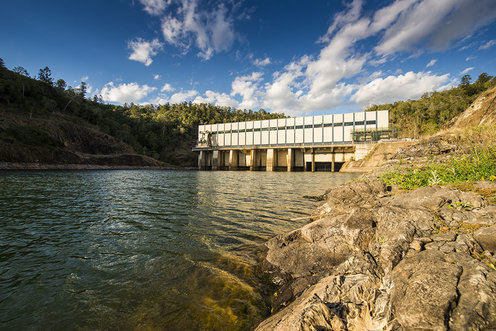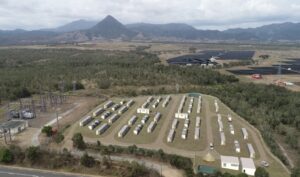Remember the scene in Monty Python’s classic film, The Meaning of Life, where a hugely obese customer, Mr Creosote, is offered a single after-dinner mint, at the end of an enormous feast. “Please sir, just one more, suggests the waiter.”
Last week, the Queensland state government generation company CS Energy – which has been feasting on record earnings over the last few years – was offered considerably more than a single “wafer-thin” incentive to begin pumping water from what it says are the largest hydro machines in the country at its Wivenhoe pumped hydro storage facility near Brisbane.
Unlike Mr Creosote, who buckled under the waiter’s insistence, took the after-dinner mint and exploded into a gazillion pieces, CS Energy refused the temptation of being paid up to $1,000 a megawatt hour to pump water uphill, and left its machines in the off position.
The market has been wondering why.
After all, being paid $1,000/MWh to charge what CS Energy describes as the country’s biggest battery unit is surely the ultimate in energy storage strategies. At a modest rate of 100MW, it stood – at least in theory – to be paid $100,000 an hour for the privilege. At its full capacity of 570MW, it stood to make $570,000 an hour. (Although it is unlikely the prices would have stayed that low for long if it was to switch on).
And while Wivenhoe stood still during last week’s extraordinary negative pricing events – when a network constraint meant little excess power could be exported south to NSW, and prices plunged into negative territory for long periods – its fellow government-owned generator Stanwell actually increased production from its fleet of coal generators near the lowest price point, and most large scale solar farms in the state were forced, or chose, to switch off for long intervals.
RenewEconomy asked both the Queensland energy minister’s office, and CS Energy, why Wivenhoe did not pump. And it turns out that, like Mr Creosote, the upper reservoir of the Wivenhoe storage facility was already full. Or, it was in their words, “sufficiently charged.”
A spokesperson for the Department of Natural Resources, Mines and Energy (DNRME) said the recent negative prices “reflect the convergence of low seasonal demand, high solar output, transmission constraints that limited export of generation south, and likely were also influenced by contract positions and commercial decisions of generators.”
The spokesperson also noted the complexity of NEM market trading conditions, system requirements and the different operational characteristics of renewable, hydro, gas and coal fired generators influence how generators bid into the market.
“For example, coal generators may at times balance the significant cost of stopping and starting coal generators by continuing to bid during temporary periods of negative prices. Conversely, some generators, including renewables, may have contractual limitations either preventing or limiting them running when prices are negative.
“Specifically in relation to Wivenhoe, they did not pump during last week’s negative pricing because Splityard Creek (the upper reservoir) had sufficient water reserves.”
 RenewEconomy asked what was meant by “sufficient water reserves” and then why, having discharged and emptied some of the top reservoir, did Wivenhoe not pump on the Thursday when prices again plunged towards the price floor (see graph above).
RenewEconomy asked what was meant by “sufficient water reserves” and then why, having discharged and emptied some of the top reservoir, did Wivenhoe not pump on the Thursday when prices again plunged towards the price floor (see graph above).
In fact, Wivenhoe did not pump again until Saturday, when prices were in positive territory, albeit low. It pumped again on Sunday as prices fell into negative territory again.
“By sufficient water supplies, we mean that we had ample water in the split yard creek reservoir,” a spokesperson for CS Energy said by email. “We pumped on the 1st, 7th and 8th, which included periods of low prices, and we generated on the 4th.
“It is important to remember that CS Energy manages all of its assets on a portfolio basis. That means we run Wivenhoe Power Station in the NEM as part of our portfolio of trading assets and the company’s broader commercial considerations.”
The latter is an important point. Portfolio trading, and the complexity of contracts and hedges means that not everything is as it seems. And Allan O’Neil at WattClarity, published an interesting article last week about why increasing output from coal generators as the price plunged towards the floor may have actually enhanced profits.
But here’s the thing. Ever since rooftop solar started to loom as a threat and as a new competitor at the start of the decade, the Queensland government owned generators have been complaining about the impact rooftop solar would have on their assets and their profits.
Of particular concern is the emergence of the so-called “duck curve” that hollows out daytime demand and requires other generators to ramp down and then up more quickly than the coal generators might want to, or are capable of.
(And it turns out that CS Energy – which owns Callide and Kogan Creek generators, and has trading rights to Gladstone – actually hired a Mr Duck (Colin) last year as head of asset management to address this issue.)
And the negative prices in Queensland were used the following days – including by Australian Energy Market Operator Audrey Zibelman – to reinforce her call for changes in the market design, so as to introduce “capacity” or flexibility” pricing, which the coal generators hope will be favourable to their assets. The Australian, as we reported, used it as a call to subsidise coal.
So, here we have a remarkable picture where high wholesale power prices, often engineered, are used as an argument against wind and solar and the need for more back-up capacity, and negative prices are then used as an argument for changes to system design to reward the coal and gas generators.
The reality is that the answer lies in more storage and dispatchable capacity – be it battery, pumped hydro, or demand management – which is clearly the cheapest, most efficient, most reliable and least polluting answer to the grid’s challenges as it brings on as more low-cost “bulk” capacity as it can, which means more wind and solar.
The Queensland government is making the first good move, shifting the little used Wivenhoe across to a new government-owned generator called CleanCo, which – from late October – will operate this asset as part of a portfolio that will include renewables.
So, barring the mind-blowing complexity of hedges and contracts, it would be reasonable to assume it would switch on at such times of negative pricing in the future, and allow the wind and solar farms to keep generating. It may even help solve Mr Duck’s duck curve problem.
The plan is for more. The Queensland government is committing $130 million to make sure Genex can link its proposed 250MW pumped hydro facility to be built at the old Kidston gold mine in north Queensland to the main grid with a properly sized connection, and add more solar and wind.
Storage facilities are being proposed all across the grid. There are at least five serious proposals for pumped hydro storage in South Australia, several in NSW, and then there are the immense Snowy 2.0 and Tasmania’s “battery of the nation” projects, both of which also rely on major transmission investments to transport their capabilities and make themselves useful.
And battery storage is also growing. By the end of this year there should be eight grid-scale batteries in operation – Hornsdale, Dalrymple, Lake Bonney, Lincoln Gap in South Australia, Gannawarra and Ballarat in Victoria, and Kennedy and Lakeland in Queensland – and many, many more in the pipeline.
 Rystad Energy estimates that more than 5GW of storage capacity was added to the pipeline of projects in 2018, and another 7GW has been added in 2019.
Rystad Energy estimates that more than 5GW of storage capacity was added to the pipeline of projects in 2018, and another 7GW has been added in 2019.
So yes, a market re-think is needed. Australia has three pumped hydro facilities – Wivenhoe, Tumut and Shoalhaven – that are little used, largely because of their modest “portfolio” role. After all, pumped hydro largely exists across the world to act as “back-up” to coal and nuclear plants.
But there is so much more that they can do. A market design is needed to liberate these assets, and encourage others to be built – both pumped hydro and batteries and also hydrogen storage – to support a clean energy system of the future, rather than the old system of the past.
Otherwise, like Mr Creosote, it’s all going to end in a bit of a mess.








